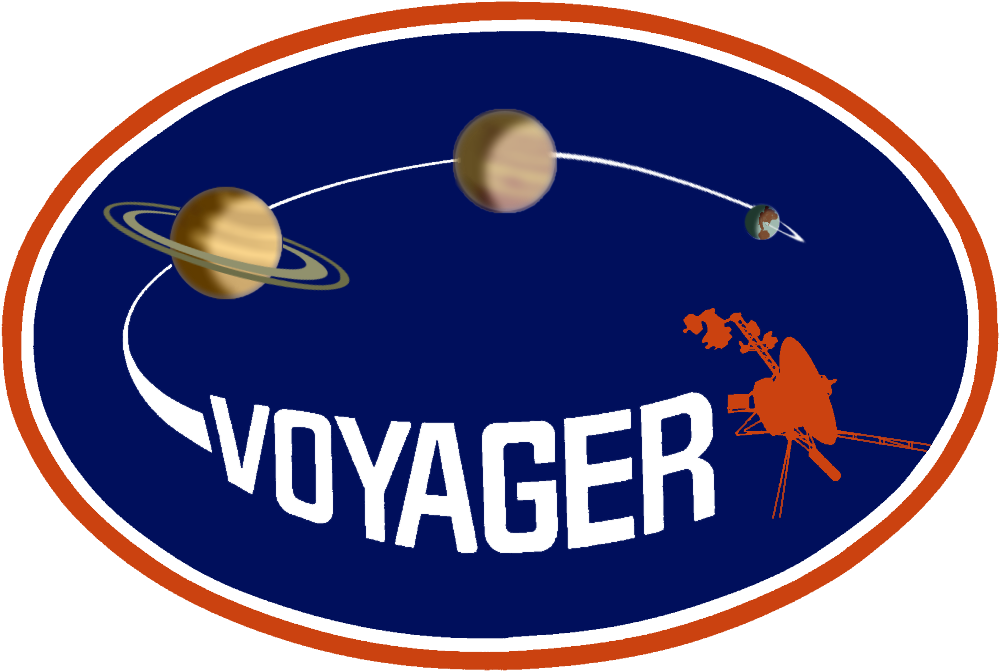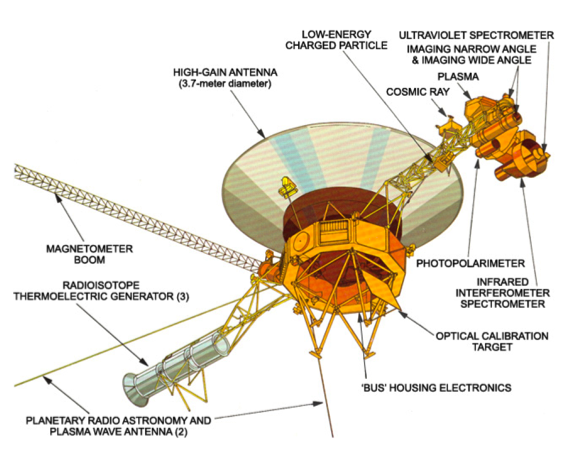- To determine the scattering properties of the lower planetary atmospheres.
- To determine the distribution of constituents with height.
- To determine the extent and distribution of hydrogen corona of the planets and satellites.
- To investigate night airglow and auroral activity.
- To determine the UV scattering properties and optical depths of planetary rings.
- To search for emissions from the rings and from any ring "atmosphere."

Instrument Characteristics
The Voyager 1 Ultraviolet Spectrometer (UVS) is a compact Wadsworth mounted objective grating spectrometer that covers the wavelength range of 0.0535 to 0.1702 micron for Voyager 1 and 0.0513 to 0.1680 micron for the Voyager 2. A mechanical 'collimator’ defines the main 'airglow' field-of-view (FOV) of 0.10 x 0.87 degrees full-width-half-maximum (FWHM). Light passing through the collimator strikes the concave diffraction grating at near normal incidence. The grating disperses and focuses light onto a 1-d array detector that records individual photoevents. An auxiliary field-of-view for solar occultation experiments is offset 20 degrees from the airglow field by a small mirror near the front of the collimator. Using this 'occultation port', UVS can view the Sun without pointing the main field, and those of other coaligned instruments, directly at the Sun. The occultation field is 0.25 x 0.87 degrees. A sunshade prevents illumination of the main entrance aperture by the sun during occultation observations.
UVS Science Objectives
References Helpful in Scoping the Mission
Mission Description
Spacecraft Description
Spacecraft Description
The UVS Data
The Bundle is located at https://atmos.nmsu.edu/PDS/data/PDS4/vg_uvs_bundle/
Maps of Hydrogen Lyman-alpha and Molecular Hydrogen bands derived from Voyager 1 and 2 Ultraviolet Spectrometer (UVS) observations obtained during North/South mapping sequences of Jupiter. The incorporated pointing information has been updated with image navigation techniques (C-smithed).
Instrument Description
Also see Space Science Reviews 21 (1977)– Issue 2) 183-205.
Data Set Overview
Voyager 1 Jupiter dataset
Voyager 2 Jupiter dataset
Voyage 1 Saturn dataset
Voyager 2 Saturn datase
Also see Space Science Reviews 21 (1977)– Issue 2) 183-205.
Data Set Overview
Voyager 1 Jupiter dataset
Voyager 2 Jupiter dataset
Voyage 1 Saturn dataset
Voyager 2 Saturn datase
The UVS calibrated (RDR) data are presented in a binary table form. Each data file consists of the data from a single day at whatever time resolution the UVS data were originally transmitted from the spacecraft. The structure of the binary files is defined.
Jupiter References
Broadfoot, A.L., et al., Extreme Ultraviolet Observations from Voyager 1 Encounter with Jupiter, Science, 204, 979, 1979.
Broadfoot, A.L., et al., Overview of Voyager Ultraviolet Spectrometry Results Through Jupiter Encounter, J. Geophys. Res., 86, 8259-8284, 1981.
Broadfoot, A.L., et al., Overview of Voyager Ultraviolet Spectrometry Results Through Jupiter Encounter, J. Geophys. Res., 86, 8259-8284, 1981.
Data
Derived
vg_2101 VG1/VG2 JUPITER UVS 5 BRIGHTNESS NORTH/SOUTH MAPS V1.0
Saturn References
Broadfoot, A.L., et al., Extreme Ultraviolet Observations from Voyager 1 Encounter with Saturn, Science, 212, 206, 1981.
Data
Derived
vg_2101 Voyager 1 & 2 Saturn UVS Brightness North-South Maps
Titan -The Titan data are interspersed with the Saturn data. Voyager 1, the close encounter, spans 1980-08-27 to 1980-11-15 with closest approach occurring at 1980-11-11 at 9:41 at a distance of 6490 km. Voyager 2 spans 1981-06-24 to 1981-08-25 Data
Calibrated
vg_2207 VOYAGER 1 SATURN ENCOUNTER:1980-08-22 TO 1980-09-21
vg_2208 VOYAGER 1 SATURN ENCOUNTER:1980-09-22 TO 1980-10-15
vg_2209 VOYAGER 1 SATURN ENCOUNTER:1980-10-16 TO 1980-11-12
vg_2210 VOYAGER 1 SATURN ENCOUNTER:1980-11-13 TO 1980-12-14
vg_2211 VOYAGER 2 SATURN ENCOUNTER:1981-06-05 TO 1981-07-01
vg_2212 VOYAGER 2 SATURN ENCOUNTER:1981-07-02 TO 1981-07-30
vg_2213 VOYAGER 2 SATURN ENCOUNTER:1981-07-31 TO 1981-08-25
vg_2208 VOYAGER 1 SATURN ENCOUNTER:1980-09-22 TO 1980-10-15
vg_2209 VOYAGER 1 SATURN ENCOUNTER:1980-10-16 TO 1980-11-12
vg_2210 VOYAGER 1 SATURN ENCOUNTER:1980-11-13 TO 1980-12-14
vg_2211 VOYAGER 2 SATURN ENCOUNTER:1981-06-05 TO 1981-07-01
vg_2212 VOYAGER 2 SATURN ENCOUNTER:1981-07-02 TO 1981-07-30
vg_2213 VOYAGER 2 SATURN ENCOUNTER:1981-07-31 TO 1981-08-25
Uranus References
Broadfoot, A.L., et al., Ultraviolet Spectrometer Observations of Uranus, Science, 233, 74, 1986.
Broadfoot, A.L., et al., Ultraviolet Spectrometer Observations of Uranus, Science, 233, 74, 1986.
Broadfoot, A.L., et al., Ultraviolet Spectrometer Observations of Uranus, Science, 233, 74, 1986.
Data
Neptune References
Broadfoot, A.L., et al., Ultraviolet Spectrometer Observations of Neptune and Triton, Science, 246, 1459, 1989.
Data
Other Documentation
PDS recommendations for citing data sets can be found here.
Jupiter
Sandel, B.R., (1995), Voyager 1&2 UVS Jupiter Brightness North/South Maps V1.0, PDS Atmospheres (ATM) Node, https://doi.org/10.17189/3n4p-jz98
Sandel, B.R., (1997), Voyager 1 Jupiter Ultraviolet Spectrometer Subsystem Calibrated Data V1.0, PDS Atmospheres (ATM) Node, https://doi.org/10.17189/4p9r-gc87
Sandel, B.R., (1997), Voyager 2 Jupiter Ultraviolet Spectrometer Subsystem Calibrated Data V1.0, PDS Atmospheres (ATM) Node, https://doi.org/10.17189/0w47-dq75
Neptune
Sandel, B.R., (1997), Voyager 2 Neptune Ultraviolet Spectrometer Subsystem Data Archive V1.0, PDS Atmospheres (ATM) Node, https://doi.org/2e17-9r73
Saturn
Sandel, B.R., (1995), Voyager 1&2 Saturn UVS Brightness North/South Maps V1.0 PDS Atmospheres (ATM) Node, https://doi.org/10.17189/azp6-vs59
Sandel, B.R., (1997), Voyager 1 Saturn Ultraviolet Spectrometer Calibrated Data V1.0, PDS Atmospheres (ATM) Node, https://doi.org/10.17189/8ads-fr53
Sandel, B.R., (1997), Voyager 2 Saturn Ultraviolet Spectrometer Data Archive V1.0, PDS Atmospheres (ATM) Node, https://doi.org/10.17189/emh4-v313
Uranus
Sandel, B.R., (1997), Voyager 2 Uranus Ultraviolet Spectrometer Subsystem Data Archive V1.0, PDS Atmospheres (ATM) Node, https://doi.org/10.17189/f8jq-h023
Jupiter
Sandel, B.R., (1995), Voyager 1&2 UVS Jupiter Brightness North/South Maps V1.0, PDS Atmospheres (ATM) Node, https://doi.org/10.17189/3n4p-jz98
Sandel, B.R., (1997), Voyager 1 Jupiter Ultraviolet Spectrometer Subsystem Calibrated Data V1.0, PDS Atmospheres (ATM) Node, https://doi.org/10.17189/4p9r-gc87
Sandel, B.R., (1997), Voyager 2 Jupiter Ultraviolet Spectrometer Subsystem Calibrated Data V1.0, PDS Atmospheres (ATM) Node, https://doi.org/10.17189/0w47-dq75
Neptune
Sandel, B.R., (1997), Voyager 2 Neptune Ultraviolet Spectrometer Subsystem Data Archive V1.0, PDS Atmospheres (ATM) Node, https://doi.org/2e17-9r73
Saturn
Sandel, B.R., (1995), Voyager 1&2 Saturn UVS Brightness North/South Maps V1.0 PDS Atmospheres (ATM) Node, https://doi.org/10.17189/azp6-vs59
Sandel, B.R., (1997), Voyager 1 Saturn Ultraviolet Spectrometer Calibrated Data V1.0, PDS Atmospheres (ATM) Node, https://doi.org/10.17189/8ads-fr53
Sandel, B.R., (1997), Voyager 2 Saturn Ultraviolet Spectrometer Data Archive V1.0, PDS Atmospheres (ATM) Node, https://doi.org/10.17189/emh4-v313
Uranus
Sandel, B.R., (1997), Voyager 2 Uranus Ultraviolet Spectrometer Subsystem Data Archive V1.0, PDS Atmospheres (ATM) Node, https://doi.org/10.17189/f8jq-h023
Publications - A listing of team members to facilitate literature searches.
Observation geometry in "SPICE" format may be obtained at the NAIF node
 PDS: The Planetary Atmospheres Node
PDS: The Planetary Atmospheres Node


